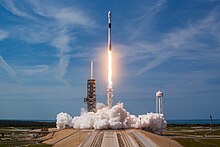
Back فالكون 9 بلوك 5 Arabic ফ্যালকন ৯ ব্লক ৫ Bengali/Bangla فاڵکۆن ٩ بلۆک ٥ CKB Falcon 9 Block 5 Czech Falcon 9 Block 5 Spanish Falcon 9 Block 5 ID Falcon 9 Block 5 Italian ファルコン9ブロック5 Japanese 팰컨 9 블록 5 Korean Falcon 9 Block 5 Polish
 Bangabandhu-1 was the first payload launched by Falcon 9 Block 5 | |
| Function | Medium-lift launch vehicle |
|---|---|
| Manufacturer | SpaceX |
| Country of origin | United States |
| Size | |
| Height | 69.8 m (229 ft) with payload fairing 65.7 m (216 ft) with Crew Dragon 63.7 m (209 ft) with Dragon[1] |
| Diameter | 3.7 m (12 ft)[2] |
| Mass | 549,000 kg (1,210,000 lb)[2] |
| Stages | 2 |
| Capacity | |
| Payload to LEO | |
| Orbital inclination | 28.5° |
| Mass | |
| Payload to GTO | |
| Orbital inclination | 27° |
| Mass | |
| Payload to TMI | |
| Mass | 4,000 kg (8,800 lb)[3] |
| Associated rockets | |
| Family | Falcon 9 |
| Based on | Falcon 9 Full Thrust |
| Comparable | |
| Launch history | |
| Status | Active |
| Launch sites |
|
| Total launches | 334 |
| Success(es) | 333 |
| Failure(s) | 1 (Starlink Group 9–3[a]) |
| Landings | 337 / 342 attempts[b] |
| First flight | 11 May 2018 (Bangabandhu-1) |
| Type of passengers/cargo | |
| First stage | |
| Height | 41.2 m (135 ft) |
| Diameter | 3.7 m (12 ft) |
| Powered by | 9 × Merlin 1D+ |
| Maximum thrust | 7.6 MN (1,700,000 lbf)[5][6] |
| Propellant | LOX / RP-1[7] |
| Second stage (standard) | |
| Height | 13.8 m (45 ft) |
| Diameter | 3.7 m (12 ft) |
| Powered by | 1 × Merlin 1D Vacuum |
| Maximum thrust | 934 kN (210,000 lbf)[2] |
| Propellant | LOX / RP-1 |
| Second stage (short nozzle) | |
| Height | 13.6 m (45 ft) |
| Diameter | 3.7 m (12 ft) |
| Powered by | 1 × Merlin 1D Vacuum |
| Maximum thrust | 840 kN (190,000 lbf)[2] |
| Propellant | LOX / RP-1 |
Falcon 9 Block 5 is a partially reusable, human-rated, two-stage-to-orbit, medium-lift launch vehicle[c] designed and manufactured in the United States by SpaceX. It is the fifth major version of the Falcon 9 family and the third version of the Falcon 9 Full Thrust.[8][9] It is powered by Merlin 1D engines burning rocket-grade kerosene (RP-1) and liquid oxygen (LOX).
The main changes from Block 3 (the original Falcon 9 Full Thrust) to Block 5 are higher-thrust engines and improvements to the landing legs along with numerous other small changes to streamline recovery and re-use of first-stage boosters and increase the production rate. Each Block 5 booster is designed to fly ten times with only minor maintenance between launches and potentially up to 100 times with periodic refurbishment.
In 2018, Block 5 succeeded the transitional Block 4 version. The maiden flight of the Block 5 launched the satellite Bangabandhu-1 on May 11, 2018. The CRS-15 mission on June 29, 2018, was the last to be launched on a Block 4 rocket, completing the transition to an all-Block 5 fleet.[10][11]
- ^ "Falcon User's Guide" (PDF). January 14, 2019. Archived from the original (PDF) on December 2, 2020. Retrieved February 26, 2019.
- ^ a b c d "Falcon 9". SpaceX. November 16, 2012. Retrieved April 30, 2016.
- ^ a b c d "Capabilities & Services (2016)". SpaceX. November 28, 2012. Archived from the original on August 2, 2013. Retrieved May 3, 2016.
- ^ Sesnic, Trevor (February 25, 2024). "Starlink Group 6-39 – Falcon 9 Block 5". Everyday Astronaut. Retrieved February 25, 2024.
- ^ SpaceX (May 11, 2018). "Bangabandhu Satellite-1 Mission". Retrieved February 25, 2019 – via YouTube.
- ^ SpaceX. "FALCON 9". SpaceX. Archived from the original on July 15, 2013. Retrieved March 2, 2019.
- ^ @elonmusk (December 17, 2015). "-340 F in this case. Deep cryo increases density and amplifies rocket performance. First time anyone has gone this low for O2. [RP-1 chilled] from 70F to 20 F" (Tweet). Retrieved December 19, 2015 – via Twitter.
- ^ "Falcon 9 & Falcon Heavy". Archived from the original on July 21, 2020. Retrieved February 3, 2021.
The v1.2 design was constantly improved upon over time, leading to different sub-versions or "Blocks". The initial design, flying on the maiden flight, was thus referred to as Block 1. The final design which has largely stayed static since 2018 is the Block 5 variant.
- ^ "Acme Engineering". Retrieved February 3, 2021.
- ^ Ralph, Eric (June 5, 2018). "SpaceX will transition all launches to Falcon 9 Block 5 rockets after next mission". TESLARATI.com. Retrieved February 26, 2019.
- ^ Shanklin, Emily (June 29, 2018). "Dragon Resupply Mission (CRS-15)". SpaceX. Archived from the original on May 24, 2019. Retrieved February 26, 2019.
Cite error: There are <ref group=lower-alpha> tags or {{efn}} templates on this page, but the references will not show without a {{reflist|group=lower-alpha}} template or {{notelist}} template (see the help page).